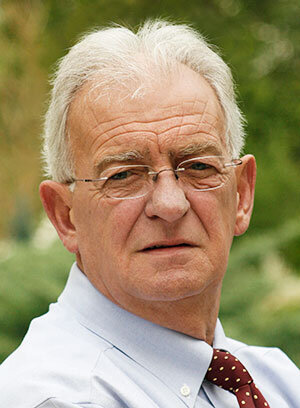Bob Daugherty
2015
Picture this:
Richard Nixon, his arms raised and fingers in a “V,” on the steps of a helicopter on the White House lawn, leaving office after resigning as President minutes earlier.
A weary Lyndon Johnson, worn down by the war in Vietnam, writing the speech that announced he would not seek re-election.
President Jimmy Carter, clasping hands with Egypt’s Anwar Sadat and Israel’s Menachem Begin on the White House lawn after the signing of the Middle East peace treaty.
President Carter, on a “town hall” trip through Bardstown, Kentucky, as he crawled out onto the roof of his car, leaning back and stretching to shake the hand of supporters who had crowded the route.
President Ronald Reagan and wife, Nancy, posing atop the Great Wall of China.
Photographer Bob Daugherty captured these images that created history's view of the world.
The son of a Kentucky sharecropper in Owingsville, Kentucky, Daugherty was born Jan. 16, 1939, to Marvin and Kathleen Daugherty. He first learned the power of photographs while peddling the weekly newspaper Grit to neighboring farmers in their fields.
One farmer said, “You know I can't read, but I sure like the pictures,” Daugherty recalls from his home in Noblesville, Indiana, where he moved after covering Washington, D.C., and traveling the world for The Associated Press.
As a youth, he began shooting with an Ansco box camera. Daugherty learned photography could be a career after his father moved the family to Marion, Indiana, to find factory work. Daugherty was taking pictures for the Marion High School yearbook when the Marion Chronicle began looking for a photographer. He was one of two sent from the high school to try out for the job. He earned the position and never looked back.
From there, he joined The Indianapolis Star for a couple of years, and then, in 1963, began his 43-year career with The Associated Press.
Daugherty said his family didn't have money for college, so “I earned my junior college degree at the Marion Chronicle, bachelor's degree at the Star and master's with The Associated Press.”
In each case, he was the youngest photographer on the job and watched carefully to learn from World War II-era photographers.
Daugherty always worked hard to be in the right spot at the right time. On Halloween night in 1963, an explosion tore through the stands of the Indiana State Fairgrounds Coliseum at its Holiday on Ice show, killing 64 and injuring 385 people. Daugherty reached the scene while rescue operations were just beginning. “I lived close and could get there quickly,” he said.
From Indianapolis, AP transferred Daugherty to Boston for nine months and ultimately, in 1967, to Washington, D.C., the place he had always wanted to be, covering politics and government at the White House. “That was where it was at; you got good exposure if you did something big,” Daugherty says.
James Polk, an AP reporter and 1994 IJHF inductee, recalls meeting Daugherty for the first time while covering President Harry Truman at the Marion Labor Day parade in 1960.
“Truman rode in an open convertible, perched atop the back seat, in a short parade around the courthouse square, ending at the entrance to the hotel where he had planned a news conference. As the car stopped, we looked up at the hotel’s marquee to see the head of a young man with his arms stretched out, a camera in his hands, dangling over the edge and shooting down to capture Truman from that unique angle.”
Polk also recalls Daugherty also captured the burning tire in mid-air as it flew toward the stands in a fiery crash that killed two drivers on the first lap of the Indianapolis 500 in 1964.
According to Polk, Daugherty photographed at least nine presidents, including Truman and Dwight Eisenhower. He covered Lyndon Johnson, Richard Nixon, Gerald Ford, Jimmy Carter, Ronald Reagan, George H.W. Bush and Bill Clinton during their terms in office.
One Saturday in 1968, Daugherty learned Johnson was at work writing a speech and he “badgered the press secretary all day” to let him in to get a picture of what turned out to be the president's declaration that he would not seek re-election.
Daugherty was on Air Force One when Nixon made his groundbreaking trip to China, photographing his handshake with Premier Zhou En-Lai.
“Bob’s travels would take him to the Middle East for the first Gulf War, to Russia, to Iceland for a presidential summit, to Omaha Beach for the 40th anniversary of D-Day, back to China again in 1984 as Ronald Reagan stood on the Great Wall,” Polk said.
The day Nixon resigned, Polk said, “Bob was the one who was able to position himself almost directly in front of the helicopter steps for those final photos.”
Hal Buell, AP’s longtime executive newsphoto editor, said “Daugherty's skill with a camera and lens selection on any story was unparalleled. But he possessed another skill, rare among picture journalists. Bob somehow was always in the right place to make the key photo. He had a political insight that warned him what would happen.
“And he was always a gentleman gifted with a great sense of humor,” Buell said.
Daugherty says he worked hard and “looked for the picture that would tell the story.”
AP colleague Richard Horwitz adds: “Bob’s talent and ability got him assigned to the important stories and best camera positions. He always came through.”
Daugherty became AP's assistant bureau chief and director for AP State Photo Center in Washington before retiring in 2007.
He is still shooting, although not commercially, and is involved with the Hamilton County Arts Association, Rotary and Kiwanis in Noblesville.
Daugherty has a sister, Alberta, who still lives in Marion. He and his wife, Stephanie, have one son, John, and a grandson, J.T.
By Linda Negro, researcher and former managing editor of the Evansville Courier & Press

